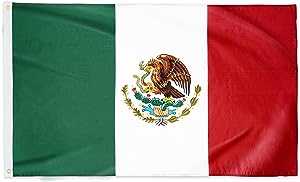Intriduction
The Mexican flag, with its vibrant tricolor design, is a symbol that represents the rich history, culture, and identity of Mexico. It is a source of pride and unity for the Mexican people, and its significance goes far beyond its visual appeal. In this article, we will explore the fascinating history of the Mexican flag, dissect its symbolism, and delve into its deep-rooted cultural importance.

Table of Contents
The Design of the Mexican Flag
The Mexican flag consists of three vertical stripes of equal width, each displaying a distinct color. From left to right, these colors are green, white, and red. The central white stripe is slightly wider than the other two and features Mexico’s national emblem, the coat of arms.
The History of the Mexican Flag
The history of the Mexican flag is intertwined with the country’s struggle for independence and sovereignty. It has undergone several transformations over the years, reflecting the changing political landscape of Mexico.
- The Aztec Empire: Long before Spanish colonization, the indigenous Aztec civilization used colorful banners and standards in warfare and religious ceremonies. These early symbols of identity and culture laid the groundwork for future Mexican flags.
- The Spanish Conquest: When the Spanish conquistadors arrived in Mexico in the early 16th century, they brought with them the flags of Spain. For nearly three centuries, Mexico was under Spanish rule, and the Spanish flag was the dominant symbol.
- The Fight for Independence: The quest for Mexican independence from Spain, led by figures like Miguel Hidalgo and José María Morelos, saw the emergence of early Mexican flags. The first “national” flag of Mexico, known as the “Flag of the Virgin of Guadalupe,” featured the image of the Virgin of Guadalupe, a significant religious figure in Mexico.
- The Design of the Modern Flag: The design of the modern Mexican flag, with its green, white, and red stripes, was officially adopted on February 24, 1821, when the Plan of Iguala was signed, marking the beginning of Mexico’s independence from Spain.
Symbolism of the Mexican Flag
Each color on the Mexican flag carries deep symbolism:
- Green: The green stripe represents the independence movement. It is a symbol of hope and the lush landscapes of Mexico.
- White: The central white stripe stands for the purity of the Catholic faith and unity among the Mexican people.
- Red: The red stripe symbolizes the bloodshed and sacrifices made by the country’s heroes during the struggle for independence and the subsequent conflicts.
The National Emblem: Coat of Arms
The national emblem, placed at the center of the white stripe, is a distinctive feature of the Mexican flag. It consists of an eagle perched on a prickly pear cactus, devouring a snake. This emblem is derived from an Aztec legend that foretold the founding of Tenochtitlan, now Mexico City, upon the sighting of this symbolic scene.
The coat of arms embodies several key elements:
- Eagle: The eagle represents courage, strength, and freedom. It is a powerful symbol of Mexico’s ability to overcome challenges and achieve independence.
- Snake: The snake, often interpreted as a symbol of evil or oppression, is being vanquished by the eagle, signifying Mexico’s triumph over adversity.
- Cactus: The cactus represents the Mexican landscape and the foundation of the nation.
Cultural Significance
The Mexican flag is not just a national symbol; it is deeply ingrained in Mexican culture and everyday life:
- Independence Day: Mexicans celebrate their independence from Spain on September 16th, known as “El Grito de Dolores.” The president reenacts Miguel Hidalgo’s cry for freedom, and the flag plays a prominent role in the festivities.
- National Holidays: The Mexican flag is prominently displayed during national holidays and celebrations, such as Cinco de Mayo and Día de la Bandera (Flag Day).
- Education: Mexican schools often have a flag ceremony, where students salute the flag, recite the national anthem, and learn about its history and significance.
- Patriotic Symbols: The Mexican flag is frequently featured in various forms of art, music, and literature, serving as a patriotic symbol that unites the nation.
- Sports: Mexican athletes proudly display the flag during international sporting events, fostering a sense of national pride and unity among fans.
Conclusion
The Mexican flag is much more than a piece of cloth; it is a powerful symbol of Mexico’s history, culture, and identity. Its tricolor design, along with the national emblem, tells a story of struggle, triumph, and unity. The flag serves as a constant reminder of the sacrifices made for independence and the enduring spirit of the Mexican people. Whether it’s waving proudly during celebrations or hanging in schools and government buildings, the Mexican flag continues to be a source of inspiration and pride for all Mexicans.